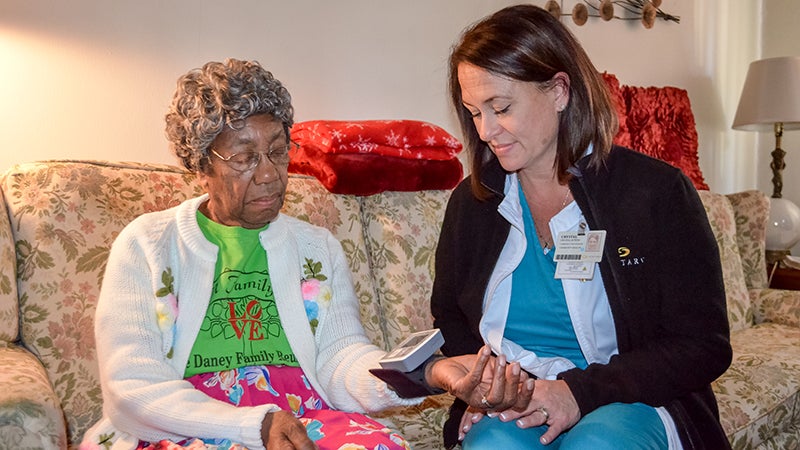CHOP nurses celebrate 20 years of patient success
Published 9:44 pm Friday, December 15, 2017

- Suffolk resident Beulah Patterson, 94, checks her blood pressure with the help of Human Resources Community Encourager Crystal Bynum with Sentara Obici Hospital. Patterson was a patient of hospital’s Community Health Outreach Program.
Tony Bryant suffered a stroke in April while cleaning fish in his backyard. After he was discharged from Sentara Obici Hospital, nurse Lisa Arrington has helped keep him living healthy in his own home.
As part of the hospital’s Community Health Outreach Program, Arrington has made weekly visits to Bryant’s downtown Suffolk residence. One of the first things she did was help him organize his pain, cholesterol and other medications in a medicine dispenser.
Color coding, easy-to-read labels, and Arrington’s great support has helped keep him out of the hospital, he said.
“She’s very good and very respectful,” he said. “I would recommend her to anybody, even the president.”
Bryant is one of more than 80 patients treated by team coordinator Barbara Kelly-Gibbs, Human Resources Community Encourager Crystal Bynum, and nurses Laurie Mercer, Kim Tidwell and Arrington. The team members spend their days driving and helping patients throughout Suffolk and Isle of Wight County, and even as far away as Boykins.
CHOP provides services for patients below the federal poverty line who are in need of at-home health care because of chronic diseases like diabetes or heart failure. The program started 20 years ago in November, with Arrington as the first visiting nurse under director Virginia Savage.
Patients were being frequently readmitted with poorly managed, chronic diseases, and the two women were determined to reduce the number of those ER visits and improve quality of life for these patients.
“No one had done this before at Obici Hospital at that time, so we had to kind of develop it as we went along,” Arrington said. “I had hundreds and hundreds of patient charts and names in front of me, and my job was to contact these people and go out to see what their barriers were.”
She put “feet to the street” to see the living conditions of the patients, she said, and the barriers she saw explained their struggles, including lack of transportation, heating and, in some cases, food.
“My eyes were opened to some of the situations people lived in,” she said. “You could very easily recognize the barriers, like when you had to make a decision between purchasing food or purchasing your medication.”
Today, the nurses address the basic living needs of the patients along with their medical needs like hypertension, pneumonia and sepsis.
Indigent patients are connected to Western Tidewater Free Clinic or the Community Health Center to establish physician relationships. The nurses help secure prescription drugs through programs and services.
If some patients have nothing to eat, then they will bring them food from churches and local food pantries.
“You have people that keep coming in with low blood sugars, but when you go to their homes, there’s no food,” Arrington said. “They were having low blood sugar because they didn’t have anything to eat.”
Beulah Patterson, 94, has a food basket delivered by Bynum right to her door, with vegetables from Seventh Day Adventist Church to go with meat and fruit Bynum got elsewhere.
Patterson, who’s lived by herself for more than 40 years, said she appreciates the assistance and care, especially during the winter.
“When it’s cold like that, I don’t get out,” she said. “I just go out back and feed the birds.”
While their cases are active, patients use telehealth remote monitoring devices, and the nurses often secure personal devices like blood pressure cuffs after cases are closed.
Bryant is able to check his blood pressure every morning with this technology, and gets a phone call from a nurse if the results are problematic. Between that and his mother, Catherine, telling him to take his medicine, his health has improved drastically, he said.
“I’ve had no sick days since, and I stopped smoking cigarettes cold turkey,” he said.
Most patient cases last 30 days, but others last longer and nurses follow up on many patients even after their cases are closed, Kelly-Gibbs said.
“We really enjoy what we do and like serving the community,” she said.
According to Bynum, the key to the program’s decades-long success has been building relationships with patients.
“Once you’re able to make that connection and there’s an acceptance between you and the patient, they trust you and they’ll start to be receptive to the education that you’re providing,” Bynum said. “They want to do better, and once you’re able to make that connection, they become empowered.”






